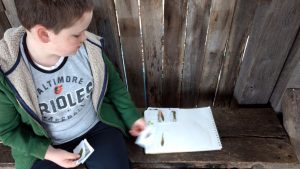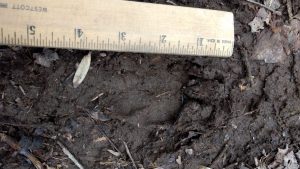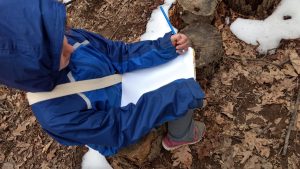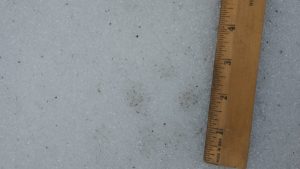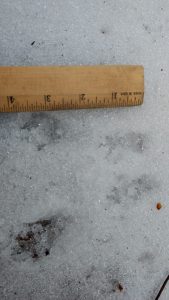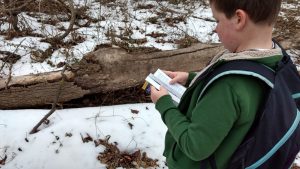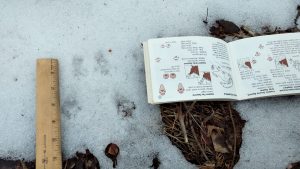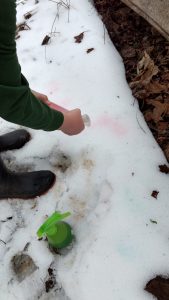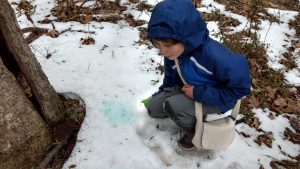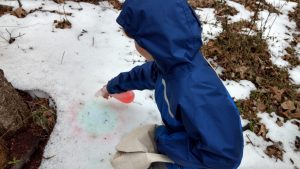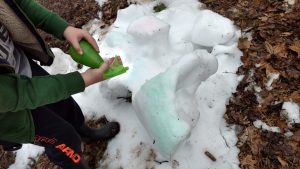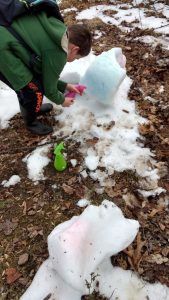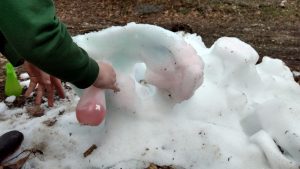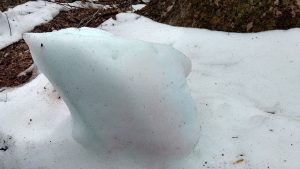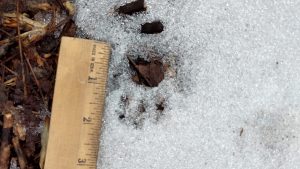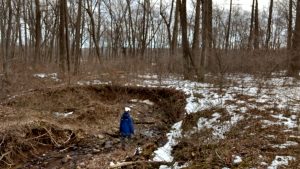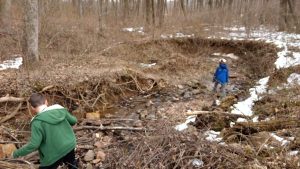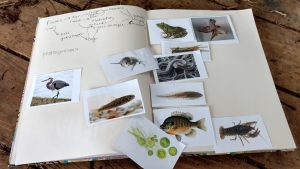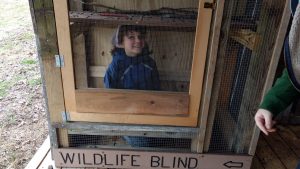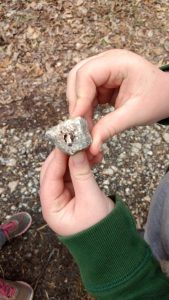Today was the first day of spring! There was also still some snow on the ground from the snow storm that hit our area last week. Because of the snow and muddy ground, it was a perfect day for looking for animal tracks, which we started right after our afternoon check-in circle and our plant phenology. A few weeks ago, when we were drawing our plants for the first time, Victoria said “Draw what you see, not what you think you see.” This is such amazing advice for anyone who has any hesitations when it comes to drawing or sketching in nature or anywhere! It helps us focus on what’s actually in front of us and reminds us not to try to create perfection when we sketch and just interpret what we see. Thank you Victoria!
Our plants hadn’t changed a whole lot today. The buds had gone slightly brown on Victoria’s spicebush but other than that, we’re still waiting for the leaves! Right as we stepped onto the trail we found a large amount of deer scat and what we think is a racoon foot print in the mud (see below in the gallery). A raccoon’s back feet are long with claws visible so that is likely what we found. It is rather difficult to identify tracks for many reasons. First, the animal could have been running, jumping or doing a movement other than walking that can alter the shape of the track. If the track is in snow, the snow does melt, so that can change the track’s appearance too. Some tracks, like a coyote or fox look very similar to a domestic dog, so it can be hard to distinguish between species. Here at Irvine, dogs aren’t allowed on the trails and coyotes are very uncommon so that helps narrow it down a bit. Which also brings us to a good tip when looking at tracks. Have a few different guides to help you out, a simple one and a more complex one are good (which is what we had) and also know the animals in the area. It is very unlikely we have fishers or ocelots running around Irvine so those are very unlikely options when reading tracks. (In the picture below you can see some squirrel tracks by the ruler!)
After some track hunting we did some snow painting! This is a really fun, creative and easy activity anyone can do in the snow and it creates beautiful scenes. We used red, blue and green food coloring in spray bottles to produce our creations.
After snow painting we headed to the creek and did a bit more in depth creek exploration. Walking along the creek we discovered some of the damaged skunk cabbage from the snow storm, but most had survived, some cool decomposing wood that was a bright reddish brown color and some shelf fungi. We also kept our eyes open for more tracks (check out all our tracks we found in the gallery below!). The snow did change our plans around a little bit, which we are adjusting for next week, so we decided to hunker down in the Ed Hut and learn a bit more about food chains, specifically of wetlands.
After brainstorming as a group a simple food chain of, lets say, a meadow or forest at Irvine, we worked on our food chain wetlands “puzzle.” A food chain is essentially a linear description of how energy passes through an ecosystem. Energy starts with plant life and then you think of what eats that plant, then what eats that animal and so forth until you reach the top of the food chain. Grass being eaten by a mouse being eaten by a snake being eaten by a hawk and then all being decomposed by worms is an example of a food chain. The hawk being the top of the food chain. Food chains don’t necessarily describe all the important connections in an ecosystem however. Food webs, which we’re learning about next week, do a better job, but food chains are a great place to start! You can see Victoria putting her wetlands food chain together below.
After food chains it was time to head back. On our hike back we saw a few bird species, such as the turkey vulture, cardinal and robins. We learned a little bit about turkey vultures and some of their very interesting survival techniques. Like how they have bald heads so they don’t get blood on their feathers as they bury their heads in carcasses, or how they go to the bathroom on their legs to keep cool or how they vomit to scare off predators or threats. They’re really crazy animals indeed but important decomposers in a lot of ecosystems.
- Charlie working on his food chain
- Possible raccoon tracks
- Victoria journaling her phenology
- Hard to see, but possibly a fox track
- More squirrel tracks
- Using a guide to identify tracks
- Here they are!
- Charlie snow painting
- Victoria snow painting
- More snow painting creations
- Check out this track, maybe a fox?
- Creek exploration
- A look at my journal with the food chain
- We found a new creature in the woods!
- Possibly mica?



